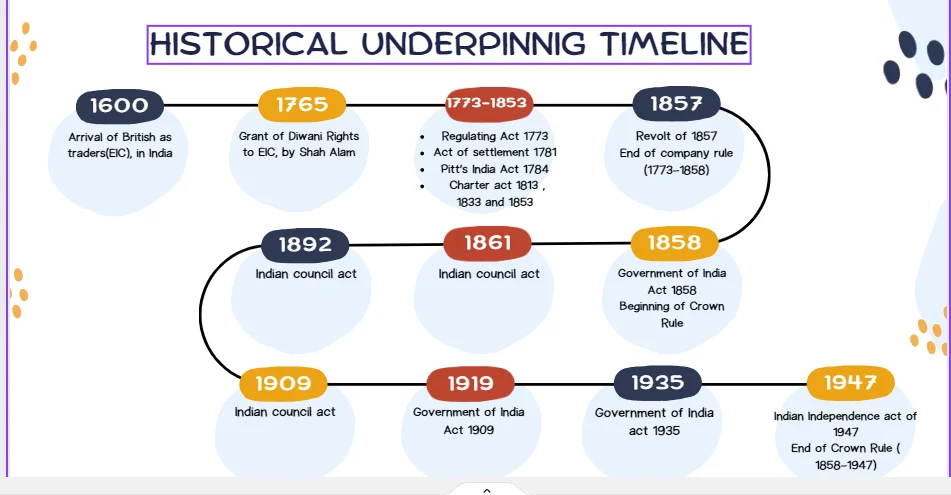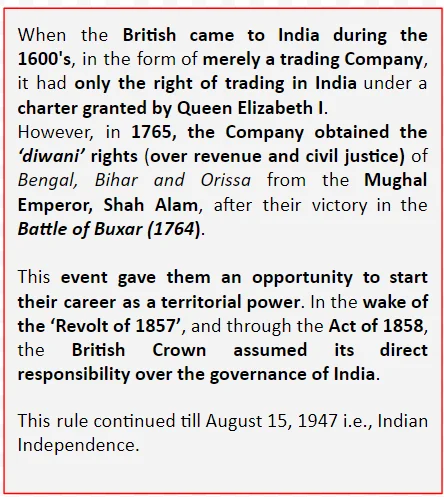Our present-day India is a federal state with its entities divided among states and union territories. It follows the system of government, which is a parliamentary democracy based on the Westminster model (Westminster is a place in London where the British Parliament is located). The foundation stone for the present federal state was laid with the advent of the Britishers in India. Certain events in British rule laid down the legal framework for the organization and functioning of government and administration in British India.
Acts enacted by the Britishers during their Rule

Enroll now for UPSC Online Course
Overview of Regulating Act of 1773 ( Governor-General Warren Hastings)
Background
- A dual system of government was introduced after the grant of Diwani of Bengal, Bihar, and Orissa, where the Company had the authority without any responsibility, and its Indian counterpart had all the responsibility without any authority. This system had the following characteristics-

-
- Corruption among servants of the Company
- Oppression of peasantry with excessive revenue collection and
- The bankruptcy of the Company, while the servants flourished.
- The British government decided to regulate the Company through this act.
Salient Features of the Regulating Act of 1773
- Establishment of a Governor-General and Council: The Act created a centralized administration in Bengal by establishing a Governor-General and Council in Calcutta.
- The council consisted of four members. This body was granted supervisory powers over the presidencies of Madras and Bombay, consolidating British authority over the East India Company’s territories in India.

- Establish Supreme Court: The Act established a Supreme Court in Calcutta, consisting of four English judges.
- This court held jurisdiction over all British subjects in Bengal, both civil and criminal.
- Regulation of the East India Company’s Dividends and Governance: The Act limited the East India Company’s dividends to 6% and restricted the terms of the Court of Directors to four years.
- This aimed to curb the Company’s financial excesses and increase oversight over its governance.
- Prohibition of Bribery and Private Trade: The Act prohibited East India Company employees from engaging in private trade or accepting bribes from natives.
- This aimed to reduce corruption and promote ethical conduct among the Company’s representatives.
- Supervision of Company’s Finances: The Act granted the British government the right to inspect the East India Company’s financial records.
- This provided greater transparency and accountability for the Company’s financial dealings.
- Supervision over the Court of Directors: The Court of Directors was supposed to report on its revenue, civil, and military affairs in India to the British Government.
| Significance | Limitations |
|
|
Amending Act of 1781 (Governor-General: Warren Hastings)
Background: To rectify the defects of the Regulating Act of 1773, the British Parliament passed the Act of Settlement, known as the Amending Act of 1781.
Key Provisions of the Amending Act of 1781
- Demarcation of Powers between the Supreme Court and the Governor-General in Council: The Act clarified the relationship between the Supreme Court and the Governor-General in Council, resolving the jurisdictional disputes that had arisen under the Regulating Act.
- It exempted the Governor-General, Council members, and Company servants from the Supreme Court’s jurisdiction in cases arising from their official duties.
- Establishment of Sadar Adalat Courts: The Act established provincial courts, known as Sadar Adalat Courts, in Bengal, Madras, and Bombay.
- These courts were intended to provide an efficient and accessible system of justice for Indians.
- The courts were to administer the personal law of the defendants.
- Regulation of Revenue Collection: The Act introduced regulations to improve the system of revenue collection in Bengal, aiming to prevent corruption and ensure fair treatment of zamindars (landowners).
- Establishment of a Board of Revenue: The Act established a Board of Revenue in Calcutta to oversee revenue collection and land administration in Bengal.
- Appeal Process: The act established that the appeals from provincial courts were to be received by the Governor General-in-Council and not the Supreme Court.
| Significance | Limitations |
| Division of Powers: It clarified the division of powers between the Supreme Court and the Governor-General in Council. | Economic and Social Issues: It did not fully address the underlying causes of India’s economic and social problems. |
| Judicial and Revenue Reforms: Established provincial courts and introduced regulations for revenue collection. | Influence of Imperial Ambitions: The East India Company’s commercial interests and the growing British imperial ambitions continued to shape the course of British rule in India |
| Civil Service Reforms: Reformed the system of civil service appointments to improve the administration of British India |
Pitt’s India Act of 1784 (Governor-General: Warren Hastings)
Background: The company continued to be plagued by corruption and mismanagement, and its financial situation deteriorated further. In addition, the act did not effectively address the growing tensions between the British and Indian rulers.
In response to these problems, William Pitt the Younger, the British Prime Minister, introduced the Pitt’s India Act of 1784. This act aimed to strengthen the British government’s control over the East India Company and improve the administration of British India.
Some of the key features are
- Subordination of the East India Company: The Pitt’s India Act gave the British government greater control over the Company’s affairs.
- In fact, the Company became a subordinate department of the State. The Company’s territories in India were termed ‘British possessions’.
- Establishment of the Board of Control: The government’s control over the Company’s affairs was greatly extended.
- A Board of Control consisting of the chancellor of exchequer, a secretary of state, and four members of the Privy Council (to be appointed by the Crown) were to exercise control over the Company’s civil, military, and revenue affairs.
- All dispatches were to be approved by the board.
- Dual System of Control Established: This dual system of control featured the Court of Directors representing the Company and the Board of Control representing the British government.
- Governor-General’s Authority in India: In India, the Governor-General was to have a council of three (including the commander-in-chief) and the presidencies of Bombay and Madras were made subordinate to the Governor-General.
- Prohibition on Aggressive Wars and Treaties: A general prohibition was placed on aggressive wars and treaties (breached often).
| Significance | Limitations |
|
|
|
|
|
Act of 1786 (Governor-General: Cornwallis)
Background: When in 1786, Cornwallis was appointed as the Governor-General of Bengal, he had placed two demands before the British Government:

- In special areas, he should be given overriding powers over the council’s decisions if he owned the responsibility for the decision.
- He should also be the Commander-in-Chief.
Enroll now for UPSC Online Course
Features: Accordingly, the Act of 1786 fulfilled both of his demands in its provisions. Cornwallis was to have the powers of both the Governor-General and the Commander-in-Chief.
| Must Read | |
| Current Affairs | Editorial Analysis |
| Upsc Notes | Upsc Blogs |
| NCERT Notes | Free Main Answer Writing |
Conclusion
Despite these legislative efforts, including the Regulating Act of 1773, the Amending Act of 1781, Pitt’s India Act of 1784, and the Act of 1786, the reforms had limited success. They addressed some administrative issues but did not fully resolve India’s economic and social problems. The Company’s rule continued to face conflicts and mismanagement, setting the stage for further changes in British colonial policy.
Sign up for the PWOnlyIAS Online Course by Physics Wallah and start your journey to IAS success today!
| Related Articles | |
| List of Governor Generals of India | Regulating Act Of 1773: Evolution, Background & Provision |
| Supreme Court | Union Territories |

 GS Foundation
GS Foundation Optional Course
Optional Course Combo Courses
Combo Courses Degree Program
Degree Program












